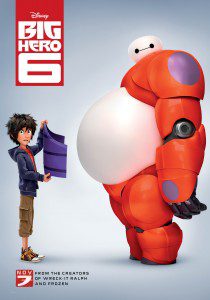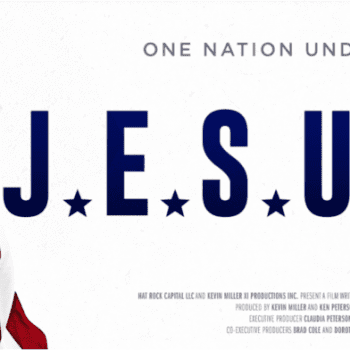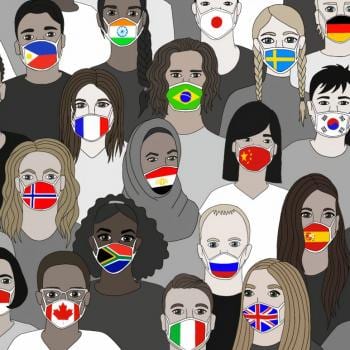“I love Baymax! He is the nicest superhero ever!” – My son, age 7
“Of all the threats presently looming over us, the most dreadful one…the only one that really matters, is ourselves.” – René Girard,
The One by Whom Scandal Comes, 3.

Big Hero 6 is Disney’s latest superhero animation film. It’s a profound story that explores the human condition. It’s a story about love, rivalry, betrayal, violence, loss, death, and healing.
As a parent of three young children, this is the movie that I’ve been looking for. Baymax is not only the nicest superhero ever, as my son exclaimed after watching the movie. Baymax is also a Christ-like superhero – a model that teaches us how to deal with the dreadful threat of our own violence through acts of love.
The Story – SPOILER ALERT!
Big Hero 6 takes place in a futuristic metropolis called San Fransokyo. The movie follows Hiro Hamada, a boy genius obsessed with creating robots to hustle people out of money in illegal, back alley robot fights. Hiro’s older brother, Tadashi, is a student at San Fransokyo Institute of Technology, or “Nerd School,” as Hiro calls it. Tadashi tricks Hiro into coming with him to the Institute, where Hiro is introduced to Tadashi’s “nerd school friends” and their inventions. Tadashi’s invention is the most important for the story – a six foot inflatable nurse robot called Baymax who is activated from sleep mode when he hears someone cry out in pain. Tadashi programmed Baymax with a microchip to be a “personal healthcare companion.” Baymax’s mission is to assess and meet “everyone’s healthcare needs.” He falls back into sleep mode when the patient says, “I’m satisfied with my care.”
Hiro is inspired by Tadashi and his friends and he now wants to join the Institute. Notice that Tadashi and his friends create a new pattern of desire in Hiro. Hiro’s desires have been reprogrammed through the process of mimetic desire. While observing the joy his friends have for being together and working on more productive science experiments, a desire builds within him to join them. After some encouragement, Hiro enters the Institute’s technology competition. If he wins the competition, he is guaranteed an opportunity to become a student at the Institute.
But we know that desire often leads to rivalry and violence. When two people desire an object that they can’t or won’t share, rivalry and violence ensues. That’s what happens when Hiro impresses the Institute with his creation of thousands of micro-bots that are controlled by a person wearing a neuro-transmitter headband.
The head professor of the Institute, Robert Callaghan, instantly invites Hiro to become a student. After Callaghan’s invitation, a high profile business technology guru named Alistair Krei offers to purchase Hiro’s microbots. The two desire the same object, and they refuse to share it, which leads them into a rivalry of escalating insults and destructive violence. After the competition, their rivalry produces a fire at the Institute. When Tadashi learns that Professor Callaghan is still in the building, he runs into the Institute save his mentor. Tragically, the building blows up and Tadashi dies in the explosion.
After Tadashi’s death, Hiro works through the grief of losing his brother and becomes distant from his new friends. When he drops his robot on his toe and yells in pain, Baymax awakens from sleep mode to care for Hiro’s healthcare needs. Baymax astutley notices that Hiro needs emotional care more than physical care.
As Hiro and Baymax work through his grief, Hiro realizes that the fire wasn’t an accident. He and his friends reunite in an effort capture a masked villain, who stole Hiro’s microbots and uses his mask as a neurotransmitter to control the microbots for his destructive purposes. Hiro decides that to capture the villain, he needs to upgrade Baymax with carbon fiber armor, rocket boosters for flying, a hand rocket punch, and a new computer chip that incorporates karate moves.
As Hiro “upgrades” Baymax to make him into a violent superhero, Baymax protests his new abilities because he knows that he was created to heal people, not hurt them. Baymax says, “I fail to see how karate makes me a better healthcare companion.”
After Hiro and his friends learn the true identity of the villain, Hiro not only wants to capture the man in the mask, he demands that Baymax kill him. But Baymax responds by saying, “My programing prevents me from injuring another human being.” Hiro, motivated by revenge, removes the healthcare chip from Baymax, leaving him with just the violent karate chip. Reprogrammed for violence, Baymax now shares Hiro’s obsession with killing the villain, but Hiro’s friends tell him that they “didn’t sign up for this.” They stop Baymax, reinsert his healthcare chip, and the villain escapes.
Back at home, Baymax asks a resentful Hiro, “Will terminating [the masked man] improve your emotional state?” Hiro responds in an understandably confused way, “Yes! No. I don’t know.” “Would Tadashi want this,” Baymax replies. “He programmed me to heal.”
Reprogrammed to Heal
Healing. It’s what all heroes and villains need. We learn that the villainous man in the mask was just like Hiro. Both of them sought revenge after losing family members. Hiro lost his brother, and the villain lost his daughter Abigail in a teleportation experiment. Abigail and her test pod were lost in the alternate dimension of the teleport. The man in the mask sought revenge on the day that the man responsible for losing his daughter opened a new facility in the heart of San Fansokyo. Using the microbots, the villain placed the last remaining portal over the building. The portal vacuumed everything in its path into its alternate dimension. It destroyed the building, sucking its broken pieces through the portal, and threatened to suck the man responsible for losing Abigail, too.
Hiro and his friends arrive just in time to stop the villain. Hiro says to the villain, “Is this what Abigail would want? Will this bring her back? Or make you feel better? Trust me, it won’t. I know.” At this point we discover that Hiro has been reprogrammed by Baymax and his friends from a desire for revenge to a desire to heal. Before this, Hiro and the villain were essentially the same. They were motivated by the same desire for revenge. The desire for violence makes heroes and villains essentially the same. The only difference between Hiro and the man in the mask is that Hiro had friends who led him away from violence and toward mercy. In that mercy for others, even for a villain, Hiro found his own healing.
But it was too late for the villain. He remained consumed by his resentment and anger. After a long struggle against the villain and his microbots, Hiro and his friends capture him and remove his mask. As the microbots fall to the ground, Baymax notices a faint human signal from within the portal.
Hiro and superhero Baymax realize the signal is from Abigail. They know that in a few minutes the portal would close, so they hurry in to save her. Baymax flies through the other dimension with his rocket launcher, avoiding the cement debris from the building. They soon find the test pod with Abigail inside. With Baymax propelling the pod forward, Hiro guides them around the debris as they fly toward the portal. In a moment of distraction, Hiro misses a large cement block floating their way. Just before it hits hero and that test pod, Baymax maneuvers himself in front to take the hit. His armor and rocket boosters break into pieces and fall away.
Baymax says the only solution is to use his rocket punch to thrust Hiro and Abigail safely through the portal. Hiro protests because he knows the rocket punch would thrust Baymax deeper into the dimesion and he doesn’t want to lose another friend. But Baymax reassures him, saying, “I’ll always be with you.” Tearfully, Hiro says, “I’m satisfied with my care” and Baymax launches his rocket fist, propelling the Hiro and the test pod through the portal, and thrusting Baymax, in a nearly cross-like shape, deeper into the alternate dimension.
I’ve seen Big Hero 6 twice with my children. At this point in the movie, my children’s eyes are glued to the screen and I’m literally in tears. From seeing Hiro suffer through loss and grief to witnessing the loyalty of his friends to seeing Hiro’s heart reprogrammed from a desire for vengeance to a desire for healing to seeing the self-sacrificial love of Baymax – this movie broke my heart and put it back together.
Baymax, Jesus, and the Gospel
As Baymax fell deeper into the portal, I couldn’t help but understand him as a Christ figure. Baymax was programmed by his creator to heal people and, if necessary, sacrifice himself for them. Baymax is not only the nicest superhero, as my son averred, he is greatest superhero I’ve seen because he acts with nonviolent love. As Jesus explained, “No one has greater love than this, to lay down one’s life for one’s friends.”
In a world that is threatened with destruction by our own rivalry and violence, Big Hero 6 is a Gospel story of hope with the Good News that like Hiro we can be reprogrammed, too. Baymax is a Christ figure because he shows that the only alternative to a desire that leads to violence that threatens our existence is a desire to offer ourselves to one another in the spirit of love and healing. Our patterns of desire can be reprogrammed by our Creator, the God who walks with us through the heartbreaking experiences of loss and grief, only to allow our broken hearts to heal and grow bigger with compassion and love.











